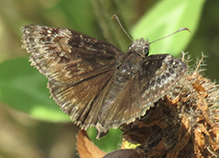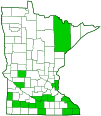IUCN Red List
not listed
(Erynnis baptisiae)
Conservation • Description • Habitat • Ecology • Distribution • Taxonomy

not listed
not listed
SU - Unrankable
not listed
Wild Indigo Duskywing is a medium-sized spread-wing skipper. It is ¾″ in length and has a wingspan of 1⅜″ to 1⅝″.
The wings are dark brown. The upperside of the forewing is very dark on the basal half, appearing “oily”. At the end of the cell there is a distinct, light, orangish-brown or reddish-brown patch. There are several spots, including a cluster of four white translucent spots at the leading edge in the region just before the tip (subapical area); two white subapical spots near the middle; and a row of pale marginal spots. The hindwing has a faint cell end bar, a row of white marginal spots, and a row of pale submarginal spots.
The antennae are short and striped. Each antenna has a black swelling (club) at the tip, and a pale, thin, hooked extension (apiculus) at the end of the club.
Total length: ¾″
Wingspan: 1⅜″ to 1⅝″
Columbine duskywing (Erynnis lucilius) is nearly identical but is much rarer. It is slightly smaller, slightly lighter, and the forewings are shorter. It may not be possible to distinguish between the two adults in the field unless the specimen is on or near a caterpillar host plant.
Fields and other grassy areas with crown vetch, roadside embankments, railroad rights-of-way
Two generations per year: Late May through June and mid-July to late August
Caterpillars feed at night. During the day they remain in a webbed shelter inside a rolled leaf.
Adults hold their wings flat when at rest.
Males perch on low shrubs in open areas waiting for passing females. The female lays eggs singly on the foliage of host plants. Larvae make a webbed shelter by rolling a leaf and tying it with silk. They live in their shelters, exiting only at night to feed. Second generation larvae overwinter in their shelters as late instar caterpillars and pupate in their shelters in the spring.
Wild indigo, lupine, and crown vetch
This skipper was originally a species of open woodlands and shrubby prairies. The larvae fed on mostly on horseflyweed (Baptisia tinctoria) but also on blue wild indigo (Baptisia australis) and on sundial lupine (Lupinus perennis). With the decline of those plant species due to habitat loss, the skipper adapted to the introduced, locally abundant species crown vetch (Securigera varia).
Nectar from flowers, including crown vetch; blackberry; blueberry; common strawberry; wild bergamot; red, white, alsike, and crimson clovers; white and yellow sweet clovers; bird’s-foot trefoil; garlic mustard; blazing stars; black-eyed Susan; prairie ironweed; chicory; Canadian horseweed; common dandelion; Joe Pye weeds; thistles; sunflowers; asters; and dogbane.

21, 24, 27, 29, 30, 75, 82, 83.
Biodiversity occurrence data published by: Minnesota Biodiversity Atlas (accessed through the Minnesota Biodiversity Atlas Portal, bellatlas.umn.edu. Accessed 12/24/2025).
Quinn, Edward. M., and Ron Danielson. April 27, 2009. A Survey of Lepidoptera in Three Priority Areas of the Minnesota State Parks System. https://files.dnr.state.mn.us/eco/nongame/projects/consgrant_reports/2009
/2009_quinn_danielson.pdf.
Widespread, abundant, and increasing in the east and the Midwest, rare in Minnesota.
NatureServe lists this species as “Unrankable” for the state of Minnesota. Its range is rapidly expanding and its numbers are increasing wherever crown vetch has been widely planted.
Order
Lepidoptera (Butterflies and Moths)
Superfamily
Papilionoidea (Butterflies)
Family
Hesperiidae (Skippers)
Subfamily
Pyrginae (Spread-wing Skippers)
Tribe
Erynnini (Duskywings and Allies)
Genus
Superfamily
Skippers have traditionally been placed in their own superfamily Hesperioidea because of their morphological similarity. Recent phylogenetic analysis (Kawahara and Breinholt [2014]) suggests that they share the same common ancestor as other butterfly families, and thus belong in the superfamily Papilionoidea.
Thanaos baptisiae
Wild Indigo Duskywing
Glossary
Apiculus
A thin hooked or pointed extension at the ends of each antennae just beyond the club of all skippers except skipperlings (subfamily Heteropterinae).
Instar
The developmental stage of arthropods between each molt; in insects, the developmental stage of the larvae or nymph.
Subapical area
In insects, the region just before the tip of the wing.
This button not working for you?
Simply email us at info@MinnesotaSeasons.com.
Attach one or more photos and, if you like, a caption.



This button not working for you?
Simply email us at info@MinnesotaSeasons.com.
Attach a video, a YouTube link, or a cloud storage link.
Wild Indigo Duskywing (Erynnis baptisiae)
Act Naturally
Wild Indigo Duskywing (Erynnis baptisiae), Great Swamp, 4-16-12
Bryan Glemboski
Wild Indigo Duskywing attempted mating
Paul Switzer
Wild Indigo Dustywing, Erynnis baptisiae, pupa
MJBugs
Wild Indigo? Duskywing laying eggs on Groundnut (Apios americana)
Tom's Biological Videography

This button not working for you?
Simply email us at info@MinnesotaSeasons.com.
Be sure to include a location.
Greg Watson
7/24/2022
John Shier
7/22/2018
